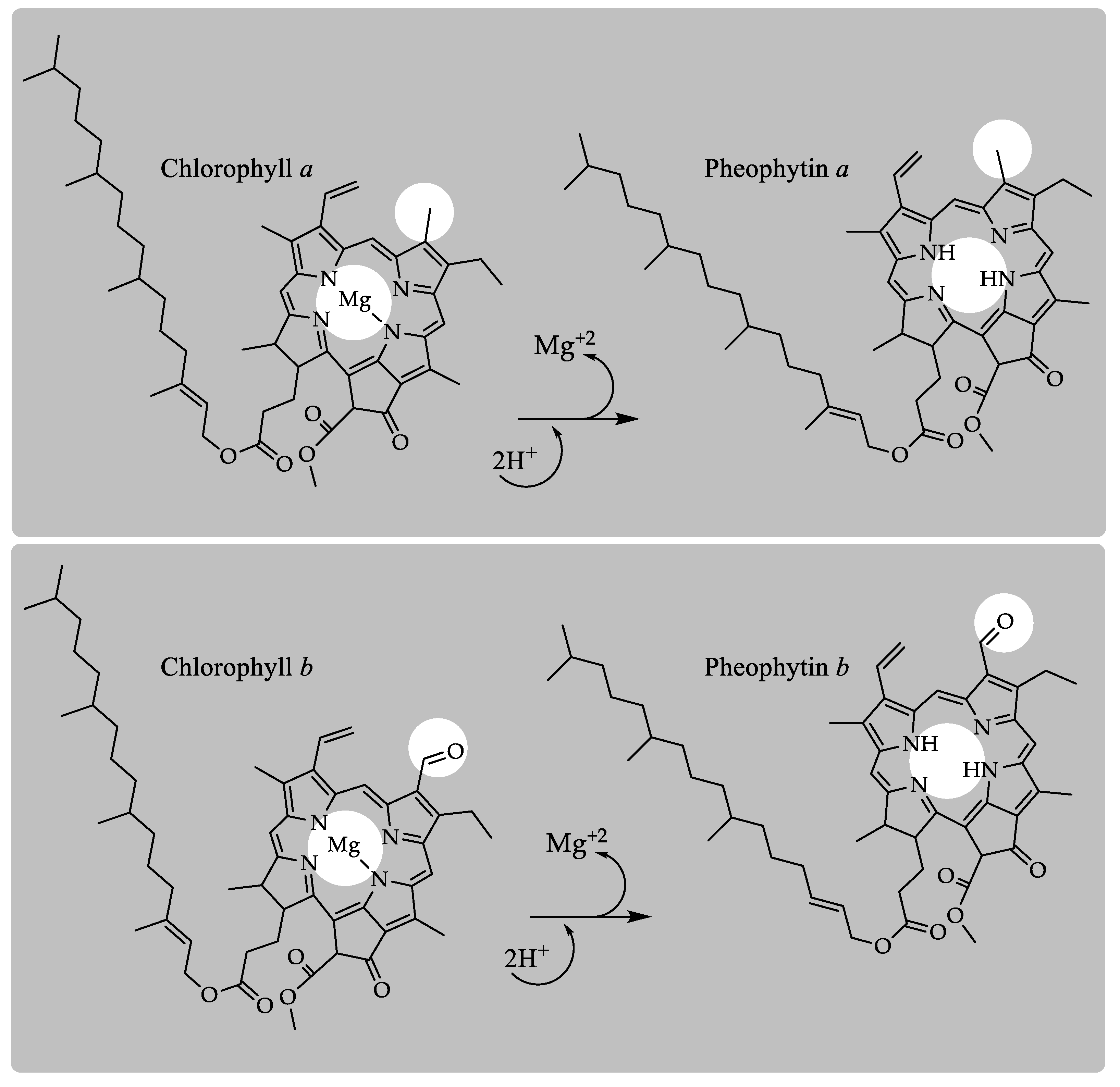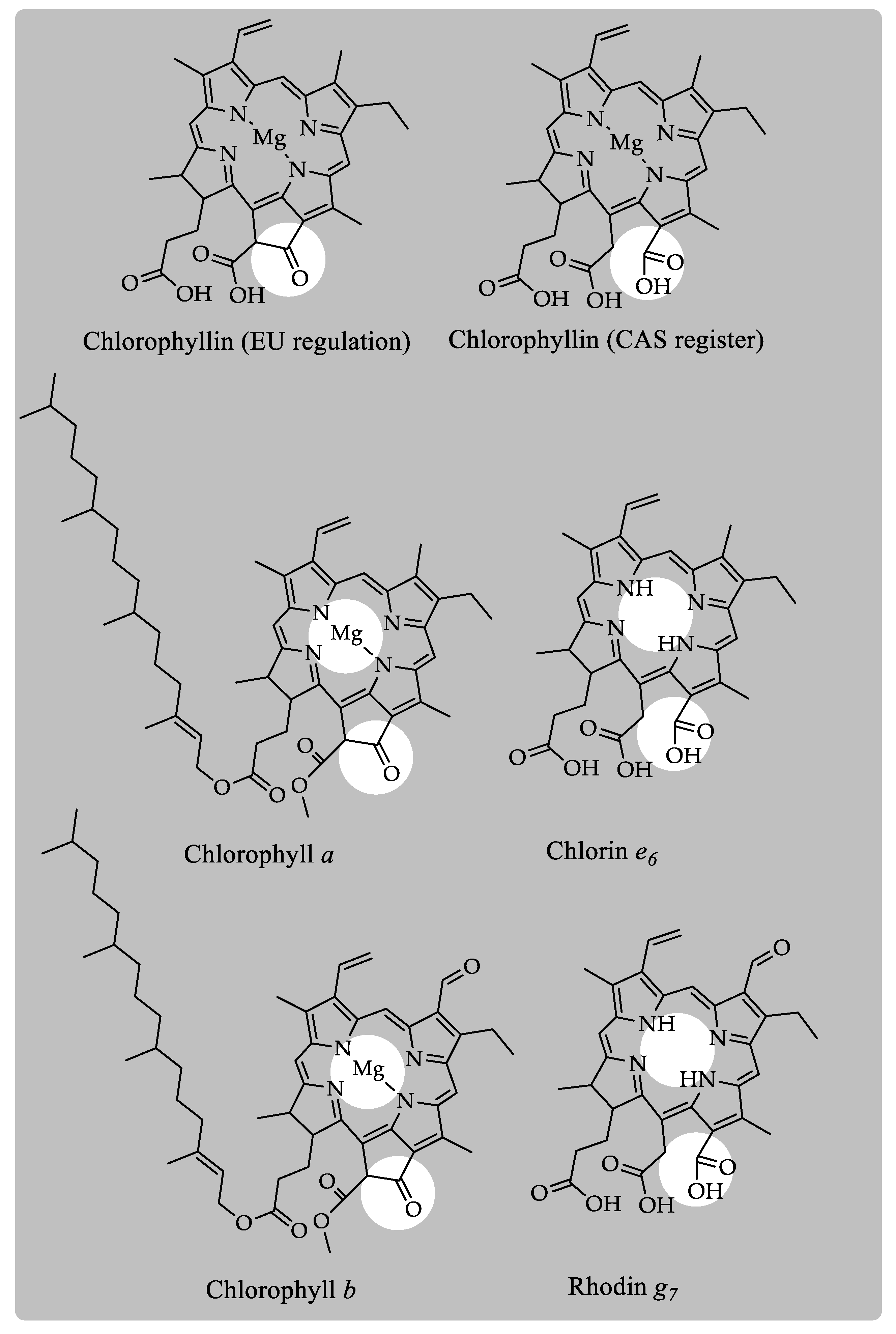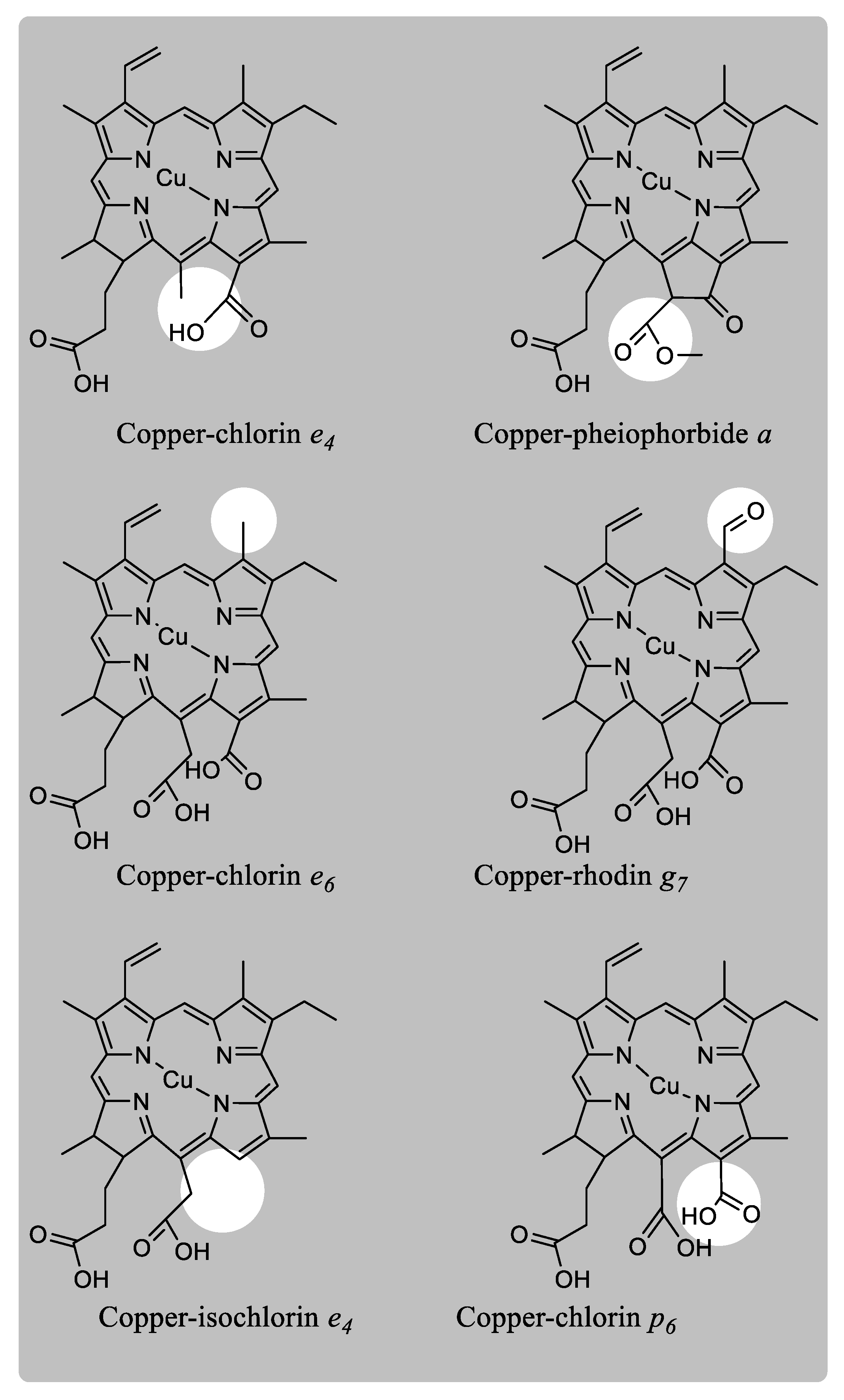Green Natural Colorants
Abstract
:1. Introduction
2. Legal Aspects on Green Natural Colorants
3. Chlorophyll Derivatives in the Authorized Natural Green Colorants
4. In Vivo and In Vitro Adsorption, Distribution, Metabolism and Excretion (ADME)
4.1. ADME of E140i
4.2. ADME of E140ii and E141i
4.3. ADME of E141ii
5. “Coloring Foodstuff”
6. Stabilization of Green Color
7. Conclusions
Author Contributions
Funding
Conflicts of Interest
References
- First Moment of Truth by Procter and Gamble. Available online: https://news.pg.com/video/first-moment-truth-30-s-reel (accessed on 5 November 2018).
- Singh, S. Impact of color on marketing. Manag. Decis. 2006, 44, 783–789. [Google Scholar] [CrossRef]
- Food Colors Market Size, Share & Trend Analysis Report by Product (Synthetic, Natural), by Application (Non-Dairy Food, CSD & Non-Alcoholic Beverages), and Segment Forecasts, 2018–2025. Available online: https://www.grandviewresearch.com/industry-analysis/food-colorants-market (accessed on 24 September 2018).
- Martins, N.; Roriz, C.L.; Morales, P.; Barros, L.; Ferreira, I.C.F.R. Food colorants: Challenges, opportunities and current desires of agroindustries to ensure consumer expectations and regulatory practices. Trends Food Sci. 2016, 52, 1–15. [Google Scholar] [CrossRef]
- Delgado-Vargas, F.; Paredes-López, O. Natural Colorants for Food and Nutraceultical Uses; CRC Press: Boca Raton, FL, USA, 2003; pp. 27–34. [Google Scholar]
- Schwartz, S.J.; Cooperstone, J.L.; Cichon, M.J.; Von Elbe, J.H.; Giusti, M.M. Colorants. In Fennema’s Food Chemistry; CRC Press: Boca Raton, FL, USA, 2017; pp. 681–752. [Google Scholar]
- US FDA Electronic Code of Federal Regulations (eCFR) Listing of Color Additives Exempt from Certification Title 21, Chapter I, Subchapter A, Part 73. Available online: https://www.ecfr.gov/cgi-bin/retrieveECFR?gp=&SID=3463c48f55ae08efd099682901bb9500&r=PART&n=pt21.1.73 (accessed on 25 September 2018).
- Regulation (EC) No 1333/2008 of the European Parliament and of the Council of 16 December 2008 on Food Additives (OJ L 354 31.12.2008, p. 16). Available online: https://eur-lex.europa.eu/eli/reg/2008/1333/2016-05-25 (accessed on 25 September 2018).
- Wrolstad, R.E.; Culver, C.A. Alternatives to Those Artificial FD&C Food Colorants. Annu. Rev. Food Sci. Technol. 2012, 3, 59–77. [Google Scholar]
- Carocho, M.; Morales, P.; Ferreira, I.C.F.R. Natural food additives: Quo vadis? Trends Food Sci. Technol. 2015, 45, 284–295. [Google Scholar] [CrossRef] [Green Version]
- Lehto, S.; Buchweitz, M.; Klimm, A.; Straßburger, R.; Bechtold, C.; Ulberth, F. Comparison of food colour regulations in the EU and the US: A review of current provisions. Food Addit. Contam. 2017, 34, 335–355. [Google Scholar] [CrossRef] [PubMed]
- McCann, D.; Barrett, A.; Cooper, A.; Crumpler, D.; Dalen, L.; Grimshaw, K.; Kitchen, E.; Lok, K.; Porteous, L.; Prince, E.; et al. Food additives and hyperactive behaviour in 3-year-old and 8/9-year-old children in the community: A randomised, double-blinded, placebo controlled trial. Lancet 2007, 370, 1560–1567. [Google Scholar] [CrossRef]
- Simon, J.E.; Decker, E.A.; Ferruzzi, M.G.; Giusti, M.; Mejia, C.D.; Goldschmidt, M.; Talcott, S.T. Establishing standards on color from natural sources. J. Food Sci. 2017, 82, 2539–2553. [Google Scholar] [CrossRef] [PubMed]
- Rodriguez-Amaya, D. Natural food pigments and colorants. Curr. Opin. Food Sci. 2016, 7, 20–26. [Google Scholar] [CrossRef]
- Ngamwonglumlert, L.; Devahastin, S.; Chiewchan, N. Natural colorants: Pigment stability and extraction yield enhancement via utilization of appropriate pretreatment and extraction methods. Crit. Rev. Food Sci. Nutr. 2017, 57, 3243–3259. [Google Scholar] [CrossRef] [PubMed]
- Oplatowska-Stachowiak, M.; Elliott, C.T. Food colors: Existing and emerging food safety concerns. Crit. Rev. Food Sci. Nutr. 2017, 57, 524–548. [Google Scholar] [CrossRef] [PubMed]
- Sigurdson, G.T.; Tang, P.; Giusti, M.M. Natural Colorants: Food Colorants from Natural Sources. Annu. Rev. Food Sci. Technol. 2017, 8, 261–280. [Google Scholar] [CrossRef] [PubMed]
- Gandul-Rojas, B.; Roca, M.; Gallardo-Guerrero, L. Detection of the color adulteration of green table olives with copper chlorophyllin complexes (E-141ii colorant). LWT Food Sci. Technol. 2012, 1, 311–318. [Google Scholar] [CrossRef]
- China Food Additive Regulation. Available online: http://www.cfsa.net.cn/Article/News.aspx?id=4486BF3709A8E32BE89BDD2A36733D3CD2A97E8CE2A3F2E2 (accessed on 26 September 2018).
- Japanese Food Additives Regulations. Available online: https://www.mhlw.go.jp/english/topics/foodsafety/foodadditives/index.html (accessed on 25 September 2018).
- The Indian Food Safety and Standards Regulations. Available online: https://www.fssai.gov.in/home/fss-legislation/fss-regulations.html (accessed on 25 September 2018).
- The Codex Alimentarius General Standard of Food Additives. Available online: http://www.fao.org/gsfaonline/additives/index.html#S (accessed on 25 September 2018).
- Roca, M.; Chen, K.; Pérez-Gálvez, A. Chlorophylls. In Handbook on Natural Pigments in Food and Beverages: Industrial Applications for Improving Food Color; Woodhead Publishing: Cambridge, UK, 2016; pp. 125–158. [Google Scholar] [Green Version]
- Scotter, M.J.; Castle, L.; Roberts, D. Method development and HPLC analysis of retail foods and beverages for copper chlorophyll (E141[i]) and chlorophyllin (E141[ii]) food colouring materials. Food Addit. Contam. A 2005, 12, 1163–1175. [Google Scholar] [CrossRef] [PubMed]
- Inoue, H.; Furuya, K.; Watanabe, K.; Tanaka, K.; Shirai, T.; Miyoshi, E. Separation and determination of copper (II) chlorophylls by reversed-phase high performance liquid chromatography. Anal. Sci. 1988, 4, 599–603. [Google Scholar] [CrossRef]
- Lian, W.; Shiuec, J.; Wang, H.; Hong, W.; Shih, P.H.; Hsu, C.K.; Huang, C.Y.; Hsing, C.R.; Wei, C.M.; Wang, J.K.; et al. Rapid detection of copper chlorophyll in vegetable oils based on surface-enhanced Raman spectroscopy. Food Addit. Contam. 2015, 32, 627–634. [Google Scholar]
- Mortensen, A.; Geppel, A. HPLC–MS analysis of the green food colorant sodium copper chlorophyllin. Innov. Food Sci. Emerg. Technol. 2007, 8, 419–425. [Google Scholar] [CrossRef]
- Pérez-Gálvez, A.; Ríos, J.J.; Roca, M. A new probe for tracking the presence of E141i food colorant. Food Control 2015, 51, 240–243. [Google Scholar] [CrossRef] [Green Version]
- Willstätter, R. Chlorophyll. J. Am. Chem. Soc. 1915, 37, 323–345. [Google Scholar] [CrossRef]
- Humphrey, A.M. Chlorophyll. Food Chem. 1980, 5, 57–67. [Google Scholar] [CrossRef]
- Del Giovine, L.; Fabietti, F. Copper chlorophyll in olive oils: Identification and determination by LIF capillary electrophoresis. Food Control 2005, 16, 267–272. [Google Scholar] [CrossRef]
- Roca, M.; Gallardo-Guerrero, L.; Mínguez-Mosquera, M.I.; Gandul-Rojas, B. Control of Olive Oil Adulteration with Copper-Chlorophyll Derivatives. J. Agric. Food Chem. 2010, 58, 51–56. [Google Scholar] [CrossRef] [PubMed]
- Yasuda, K.; Tadano, K.; Ushiyama, H.; Ogawa, H.; kawai, Y.; Nishima, T. Investigation to find an indicator substance for the analysis of sodium copper chlorophyllin in foods. J. Food Hyg. Soc. Jpn. 1995, 36, 710–716. [Google Scholar] [CrossRef]
- Inoue, H.; Yamashita, H.; Furuya, K.; Nonomura, Y.; Yoshioka, N.; Li, S. Determination of copper (II) chlorophyllin by reversed-phase high-performance liquid chromatography. J. Chromatogr. A 1994, 679, 99–104. [Google Scholar] [CrossRef]
- Chernomorsky, S.; Rancourt, R.; Sahai, D.; Poretz, R. Evaluation of commercial chlorophyllin copper complex preparations by liquid chromatography with photodiode array detection. J. AOAC Int. 1997, 80, 433–435. [Google Scholar]
- Aparicio-Ruiz, R.; Riedl, K.M.; Schwartz, S.J. Identification and quantification of metallo-chlorophyll complexes in bright green table olives by high-performance liquid chromatography-mass spectrometry quadrupole/time-of-flight. J. Agric. Food Chem. 2011, 59, 11100–11108. [Google Scholar] [CrossRef] [PubMed]
- Suzuki, I.; Kubota, H.; Terami, S.; Hara, T.; Hirakawa, Y.; Iizuka, T.; Tatebe, C.; Ohtsuki, T.; Yano, T.; Sato, K.; et al. Development of an analytical method for copper chlorophyll and sodium copper chlorophyllin in processed foods. Jpn. J. Food Chem. Saf. 2016, 23, 55–62. [Google Scholar]
- Negro, C.; De Bellis, L.; Sabella, E.; Nutricati, E.; Luvisi, A.; Micelli, A. Detection of not allowed food-coloring additives (copper chlorophyllin, copper-sulphate) in Green table olives sold on the Italian market. Adv. Hort. Sci. 2017, 31, 225–233. [Google Scholar]
- Delpino-Rius, A.; Cosovanu, D.; Eras, J.; Vilaró, F.; Balcells, M.; Canela-Garayoa, R. A fast and reliable ultrahigh-performance liquid chromatography method to assess the fate of chlorophylls in teas and processed vegetable foodstuff. J. Chromatogr. 2018, 1568, 69–79. [Google Scholar] [CrossRef] [PubMed]
- Ferruzzi, M.G.; Failla, M.L.; Schwartz, S.J. Assessment of degradation and intestinal cell uptake of carotenoids and chlorophyll derivatives from spinach puree using an in vitro digestion and Caco-2 human cell model. J. Agric. Food Chem. 2001, 49, 2082–2089. [Google Scholar] [CrossRef] [PubMed]
- Gallardo-Guerrero, L.; Gandul-Rojas, B.; Minguez-Mosquera, M.I. Digestive stability, micellarization, and uptake by Caco-2 human intestinal cells of chlorophyll derivatives from different preparations of pea (Pisum sativum). J. Agric. Food Chem. 2008, 56, 8379–8386. [Google Scholar] [CrossRef] [PubMed]
- Gandul-Rojas, B.; Gallardo-Guerrero, L.; Minguez-Mosquera, M.I. Influence of the chlorophyll pigment structure on its transfer from an oily food matrix to intestinal epithelium cells. J. Agric. Food Chem. 2009, 57, 5306–5314. [Google Scholar] [CrossRef] [PubMed]
- Chen, K.; Roca, M. In vitro bioavailability of chlorophyll pigments from edible seaweeds. J. Funct. Foods 2018, 41, 25–33. [Google Scholar] [CrossRef]
- Viera, I.; Chen, K.; Ríos, J.J.; Benito, I.; Pérez-Gálvez, A.; Roca, M. First-Pass Metabolism of Chlorophylls in Mice. Mol. Nutr. Food Res. 2018, 62. [Google Scholar] [CrossRef] [PubMed]
- Brugsch, J.T.; Sheard, C. Chlorophyll, determination and quantitative estimation of decomposition of chlorophyll in the human body. J. Lab. Clin. Med. 1938, 24, 230–234. [Google Scholar]
- Fisher, H.; Hendschel, A. Isolation of chlorophyll derivatives from the feces of elephants and human beings. Hoppe Seylers Z. Physiol. Chem. 1993, 216, 56–59. [Google Scholar]
- Baxter, H. Absorption of chlorophyll phytol in normal man and in patients with Refsum’s disease. J. Lipid Res. 1968, 9, 636–641. [Google Scholar] [PubMed]
- Fernandes, T.M.; Gomes, B.B.; Lanfer-Marquez, U.M. Apparent absorption of chlorophyll from spinach in an assay with dogs. Innov. Food Sci. Emerg. Technol. 2007, 8, 426–432. [Google Scholar] [CrossRef]
- Brink, D.M.; Wanders, R.J.A. Phytanic acid: Production from phytol, its breakdown and role in human disease. Cell Mol. Life Sci. 2006, 63, 1752–1765. [Google Scholar] [CrossRef]
- EFSA Panel on Food Additives and Nutrient Sources added to Food (ANS). Scientific Opinion on the Re-Evaluation of Chlorophylls (E 140 (i)) as Food Additives. EFSA J. 2015, 13, 4089. Available online: https://www.efsa.europa.eu/en/efsajournal/pub/4089 (accessed on 2 November 2018).
- EFSA Panel on Food Additives and Nutrient Sources added to Food (ANS). Scientific Opinion on the Re-Evaluation of Chlorophylls (E 140 (ii)) as Food Additives. EFSA J. 2015, 13, 4081. Available online: https://www.efsa.europa.eu/en/efsajournal/pub/4085 (accessed on 2 November 2018).
- EFSA Panel on Food Additives and Nutrient Sources added to Food (ANS). Scientific Opinion on the Re-Evaluation of Chlorophylls (E 141 (i and ii)) as Food Additives. EFSA J. 2015, 13, 4151. Available online: https://www.efsa.europa.eu/en/efsajournal/pub/4151 (accessed on 2 November 2018).
- EU Call for Scientific and Technical Data on the Permitted Food Additives E 140 (i) Chlorophylls, E 140 (ii) Chlorophyllins, E 141 (i) Copper Complexes of Chlorophylls and E 141 (ii) Copper Complexes of Chlorophyllins. Available online: https://ec.europa.eu/food/safety/food_improvement_agents/additives/re-evaluation_en. (accessed on 2 November 2018).
- Ferruzzi, M.G.; Failla, M.L.; Schwartz, S.J. Sodium copper chlorophyllin: In vitro digestive stability and accumulation by Caco-2 human intestinal cells. J. Agric. Food Chem. 2002, 50, 2173–2179. [Google Scholar] [CrossRef] [PubMed]
- Henderson, H.J.; Long, E.R. Accumulation of Chlorophyll Pigments in Visceral Organs and their Elimination. Exp. Biol. Med. 1941, 48, 438–439. [Google Scholar] [CrossRef]
- Reber, E.F.; Willigan, D.A. The effects of a chlorophyll derivative when included in a ration fed rats. II. Reproduction, blood, and tissue studies. Am. J. Vet. Res. 1954, 15, 643–646. [Google Scholar] [PubMed]
- Harrisson, J.W.E.; Levin, S.E.; Trabin, B. The safety and fate of potassium sodium copper chlorophyllin and other copper compounds. J. Am. Pharm. Assoc. 1954, 43, 722–737. [Google Scholar] [CrossRef]
- Park, K.K.; Surh, Y.J. Chemopreventive activity of chlorophyllin against mouse skin carcinogenesis by benzoapyrene and benzoapyrene-7,8-dihydrodiol-9,10-epoxide. Cancer Lett. 1996, 102, 143–149. [Google Scholar] [CrossRef]
- Gomes, B.; Barro, S.; Andrade-Wartha, E.; Silva, A.; Silva, V.V.; Lanfer-Marquez, U.L. Bioavailability of dietary sodium copper chlorophyllin and its effect on antioxidant defense parameters of Wistar rats. J. Sci. Food Agric. 2009, 89, 2003–2010. [Google Scholar] [CrossRef]
- Chernomorsky, S.A.; Segelman, A.B. Biological activities of chlorophyll derivatives. J. Med. 1988, 85, 669–673. [Google Scholar]
- Young, R.W.; Beregi, J.S. Use of chlorophyllin in the treatment of geriatric patients. J. Am. Geriatr. Soc. 1980, 28, 46–47. [Google Scholar] [CrossRef]
- Egner, P.A.; Stanbubury, K.H.; Snyder, E.P.; Rogers, M.E.; Hintz, P.A.; Kensler, T.W. Identification and characterisation of chlorine e4 ethyl ester in sera of individuals participating in chlorophyllin chemoprevention trial. Chem. Res. Toxicol. 2000, 13, 900–906. [Google Scholar] [CrossRef]
- Ferruzzi, M.G.; Blakeslee, J. Digestion, absorption and cancer preventive activity of dietary chlorophyll derivatives. Nutr. Res. 2007, 27, 1–12. [Google Scholar] [CrossRef]
- Guidance Notes on the Classification of Food Extracts with Colouring Properties. Available online: https://ec.europa.eu/food/sites/food/files/safety/docs/fs_food-improvement-agents_guidance_additive-eu-rules.pdf. (accessed on 6 November 2018).
- Palabiyik, I.; Durmaz, Y.; Öner, B.; Toker, O.S.; Coksari, G.; Konar, N.; Tamtürk, F. Using spray-dried microalgae as a natural coloring agent in chewing gum: Effects on color, sensory, and textural properties. J. Appl. Phycol. 2018, 30, 1031–1039. [Google Scholar] [CrossRef]
- Jones, I.; White, R.; Gibbs, E.; Butler, L.; Nelson, L. Experimental formation of zinc and copper complexes of chlorophyll derivatives in vegetable tissue by thermal processing. J. Agric. Food Chem. 1977, 25, 149–153. [Google Scholar] [CrossRef]
- Schanderl, S.H.; Marsh, G.; Chichester, C. Color reversion in processed I. Studies on regreened vegetables pea purges. J. Food Sci. 1965, 30, 312–316. [Google Scholar] [CrossRef]
- LaBorde, F.F.; von Elbe, J.H. Zinc complex formation in heated vegetables purees. J. Agric. Food Chem. 1990, 38, 484–487. [Google Scholar] [CrossRef]
- Segner, W.P.; Ragusa, T.J.; Nank, W.K.; Hoyle, W.C. Process for the Preservation of Green Color in Canned Vegetables. U.S. Patent No. 4473591, 25 September 1984. [Google Scholar]
- Von Elbe, J.H.; Huang, A.S.; Attoe, E.L.; Nank, W.K. Pigment composition and color of conventional and Veri-Green canned beans. J. Agric. Food Chem. 1986, 34, 52–54. [Google Scholar] [CrossRef]
- Porraud, S.; Pranee, A. Microencapsulation of Zn-chlorophyll pigment from Pandan leaf. Int. Food Res. 2010, 17, 1031–1042. [Google Scholar]
- Bilek, S.E.; Özkan, G. Encapsulation of zinc-chlorophyll derivatives in whey protein matrix by emulsion/cold-set gelation. J. Food 2018, 43, 174–183. [Google Scholar]
- Zhang, Z.; Peng, H.; Ma, H.; Zeng, X. Effect of inlet air drying temperatures on the physicochemical properties and antioxidant activity of whey protein isolate-kale leaves chlorophyll (WPI-CH) microcapsules. J. Food Eng. 2019, 245, 149–156. [Google Scholar] [CrossRef]
- Afsaneh Raei, A.; Ali Yasini Ardakani, S.; Daneshi, M. Microencapsulation of the green pigment of alfalfa and its applications on heated food. J. Food Process. Eng. 2017, 40. [Google Scholar] [CrossRef]







| Country | Chlorophyll | Chlorophyllin | Cu-Chlorophyll | Cu-Chlorophyllin | Na-Fe-Chlorophyllin |
|---|---|---|---|---|---|
| EU | E140i | E140ii | E141i | E141ii | |
| USA | 73.125 | ||||
| Japan | 177 | 116 | 266 | 265 | 257 |
| India | 6 | ||||
| China | 08.153 | 08.009 | |||
| CA 1 | INS 140 | INS 140 | INS 141i | INS 141ii |
| Denominations | Green S | Fast Green FCF |
|---|---|---|
| CI 1 | 44090 | 42053 |
| EU | E142 | - |
| USA | - | FD&C green No. 3 |
| Japan | - | Food green No. 3 |
| India | - | Fast green FCF |
| China | - | - |
| CA | INS 142 | INS 143 |
| Chlorophyll Compound | R1 | R2 | R3 | R4 |
|---|---|---|---|---|
| Chlorophyll a | Mg | CH3 | phytyl | COOCH3 |
| Chlorophyll b | Mg | CHO | phytyl | COOCH3 |
| Chlorophyllide a | Mg | CH3 | H | COOCH3 |
| Pheophytin a | H | CH3 | phytyl | COOCH3 |
| Pheophytin b | H | CHO | H | COOCH3 |
| Pheophorbide a | H | CH3 | H | COOCH3 |
| Pyropheophytin a | H | CH3 | phytyl | H |
| Vegetable Juice | Fruit Juice | Spirulina Extract | |
|---|---|---|---|
| European Union | |||
| + | + | + | |
| Allowed foods | Foods in general | Foods in general | Foods in general |
| Maximum limit | Quantum satis | Quantum satis | Quantum satis |
| United States | |||
| Denomination | 73,260 | 73,250 | 73,530 |
| Allowed foods | Foods generally | Foods generally | Confections (including candy and chewing gum), frostings, ice cream and frozen desserts, dessert coatings and toppings, beverage mixes and powders, yogurts, custards, puddings, cottage cheese, gelatin, breadcrumbs, ready-to-eat cereals (excluding extruded cereals), coating formulations applied to dietary supplement tablets and capsules |
| Maximum limit | GMP 1 | GMP | GMP |
© 2019 by the authors. Licensee MDPI, Basel, Switzerland. This article is an open access article distributed under the terms and conditions of the Creative Commons Attribution (CC BY) license (http://creativecommons.org/licenses/by/4.0/).
Share and Cite
Viera, I.; Pérez-Gálvez, A.; Roca, M. Green Natural Colorants. Molecules 2019, 24, 154. https://doi.org/10.3390/molecules24010154
Viera I, Pérez-Gálvez A, Roca M. Green Natural Colorants. Molecules. 2019; 24(1):154. https://doi.org/10.3390/molecules24010154
Chicago/Turabian StyleViera, Isabel, Antonio Pérez-Gálvez, and María Roca. 2019. "Green Natural Colorants" Molecules 24, no. 1: 154. https://doi.org/10.3390/molecules24010154
APA StyleViera, I., Pérez-Gálvez, A., & Roca, M. (2019). Green Natural Colorants. Molecules, 24(1), 154. https://doi.org/10.3390/molecules24010154








